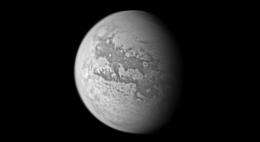The formation and development of desert dunes on Titan

Combining climate models and observations of the surface of Titan from the Cassini probe, a team from the AIM Astrophysics Laboratory (CNRS / CEA / Paris Diderot University) , in collaboration with researchers at the Paris Earth Physics Institute (IPGP / CNRS / Paris Diderot University) and the Matter and Complex Systems Laboratory - MSC (CNRS / Paris Diderot University), have proposed a new formation and growth mechanism for the dunes on the surface of the moon. This growth mechanism, also seen in some terrestrial deserts and on the planet Mars, appears to be the dominant mechanism in the deserts of Titan, explaining not only the shape of the dunes, but also their orientation and direction of growth, together with their confinement to the tropical belt around the moon. The results of this study have been published in Geophysical Research Letters.
Titan is the largest of Saturn's moons. The Cassini probe arrived in the Saturn system in 2004 with the objective of studying the giant planet and its moons, including Titan. Titan exhibits many similarities with the Earth. These include a very active climatic cycle, largely controlled by methane, and many familiar landscape features including a belt of extensive linear dune fields around the equator, hydrocarbon lakes and mountains. The dune fields occupy 17 % of the surface of Titan and provide valuable information on the climate, topology and history of the moon.
The formation of a dune requires wind of sufficient strength to move the sediment of which it is composed. The size of the dunes does not depend on the gravity of the planet or moon. Rather, it depends on the ratio of the densities of the sediment and the atmosphere. The mechanism determining the growth and orientation of the dunes depends on the local wind variability and the supply of sediment. Until now, little data on the surface of the moon has been gathered. However, mathematical models have been developed with the aim of simulating the atmosphere of Titan and the wind conditions present on the surface.
Combining data from the Cassini probe with climate and sediment transport models for the surface of the moon, a team from the AIM Astrophysics Laboratory (CNRS / CEA / Paris Diderot University), in collaboration with researchers at the Paris Earth Physics Institute (IPGP / CNRS / Paris Diderot University) and the Matter and Complex Systems Laboratory - MSC (CNRS / Paris Diderot University), have proposed a new mechanism to explain the formation of dunes on the surface of Titan. The researchers have shown that, contrary to accepted theory, the dunes on Titan could not have been formed from an entirely mobile bed of sediment. Their orientation suggests that they have formed over a non-erodable substrate consisting of either solid material or sediment with grains too large to be transported, obtaining sufficient material for their growth from a local source of sediment. In this case, they would be aligned with the resultant wind direction, maintaining a constant orientation and shape over several hundred kilometers. This correlates well with observations of the actual dunes.
Dunes of this type are also seen in many terrestrial deserts and on Mars, bearing witness to the wind regimes and sedimentary environment leading to their formation. The study has shown that strong gusts of wind caused by extreme climatic events must have been at the origin of these sediment flows. These extreme conditions occur at the equinoxes and have also been observed by the Cassini probe. The researchers have also shown that the atmospheric currents on the surface of the moon converge towards the equator, a region where the climatic conditions are the most arid, explaining both the sedimentary deposit and the concentration of dune fields in the intertropical zone. This new model of the formation and growth of the dunes of Titan is the first to explain all the observed characteristics of the Titan deserts, bringing new light to bear on the complex climatology of the moon and the still enigmatic nature of its surface.
Journal information: Geophysical Research Letters
Provided by CEA




















